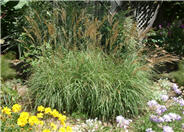
Common name:Eulalia Grass, Japanese Silver Gras
Botanical name:Miscanthus sinensis
Miscanthus sinensis is popular ornamental grass. Red flowers are held well above foliage clumps, appearing in summer, and may be cut for fresh or dry arrangements. Miscanthus needs full sun and watering at least once a week and more during hot summers. Foliage is variegated, with a thin white band down the center. This grass does great in coastal as well as warm inland valleys.
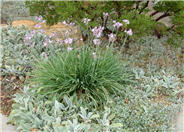
Common name:Society Garlic
Botanical name:Tulbaghia violacea
This clumping perennial will grow less than 1' tall and has narrow, blue-green leaves. Clusters of lavender flowers bloom in spring and summer. Leaves and flowers have a distinct onion or garlic smell if crushed.
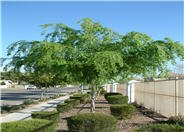
Common name:Chinese Elm, Chinese Evergreen Elm
Botanical name:Ulmus parvifolia
Chinese Elm quickly reaches 50' tall and 60' wide with an upright habit and spreading pendulous branches with age. Chinese Elm has small, dark green leaves. Foliage turns yellow or orange in fall. Small, greenish yellow flower appear in summer but are considered insignificant. Small light brown fruit appear in fall but are not noticeable. Bark is brown gray but with maturity, exfoliates to reveal orange patterns.
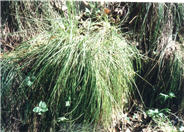
Common name:California Fescue
Botanical name:Festuca californica
The California Fescue is a cool season bunchgrass with blue-green blades that reach 2' high. The violet colored flower stalks are 5' tall, appearing in spring and summer, creating fountain-like clumps. This grass is drought tolerant for sun and shade although it looks better with additional summer water. The California fescue is native to CA and is a beneficial insect plant. Plant on dry sunny slopes or on the edge of a dry creek bed.

Common name:Japanese Maple
Botanical name:Acer palmatum
This magnificient plant can used as a small tree or shrub. It is deciduous with graceful leaves which have a scarlet color in spring as it leafs out. Leaves later turn orange or yellow in fall. It is slow growing to 20', and requires shelter from the hot sun. The leaves of this tree are small, light green in color, and deeply lobed. It should also be noted that this tree remains spectacular throughout all seasons. (2nd photo courtesy of Steve Mullany)
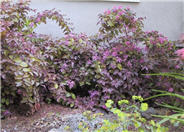
Common name:Red Fringe Flower cultivar
Botanical name:Loropetalum chinense v. rubrum
Red Fringe Flower is a shrub that grows 6'-12' tall and wide. It has arching branches with light green and reddish leaves. Pink flowers bloom intermittently throughout the year. This attractive shrub prefers afternoon shade and shelter from hot, drying winds. It needs a moderate amount of watering.
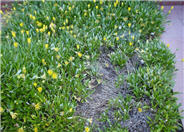
Common name:Semi-trailing Yellow Gazania
Botanical name:Gazania 'Mitsuwa Yellow'
This somewhat hardy perennial will grow 6"-12" high, spreading 3' wide. It produces wonderful, bright yellow flowers during the warm season. Plant in full sun. It is drought tolerant once it's established. This is a great ground cover for erosion control on hillsides or used as a lawn substitute.
In the natural world the endless cycle of birth, growth, decay, death and rebirth flows throughout the seasons. Plants die, leaves fall and new growth springs up in its place. Nothing is lost and the fallen leaves and dead plants decay into the soil, enriching it for the next generation of growth.
Click in the green box for more information
Designer:
Photographer: GardenSoft
Incorporate compost 6" into your soil to retain water, reduce compaction, feed earthworms, and provide valuable nutrients to your plants.
Group plants in your garden according to their water needs (hydrozone).
Attract, or buy beneficial insects such as ladybugs and lacewings to control pest outbreaks in your garden.